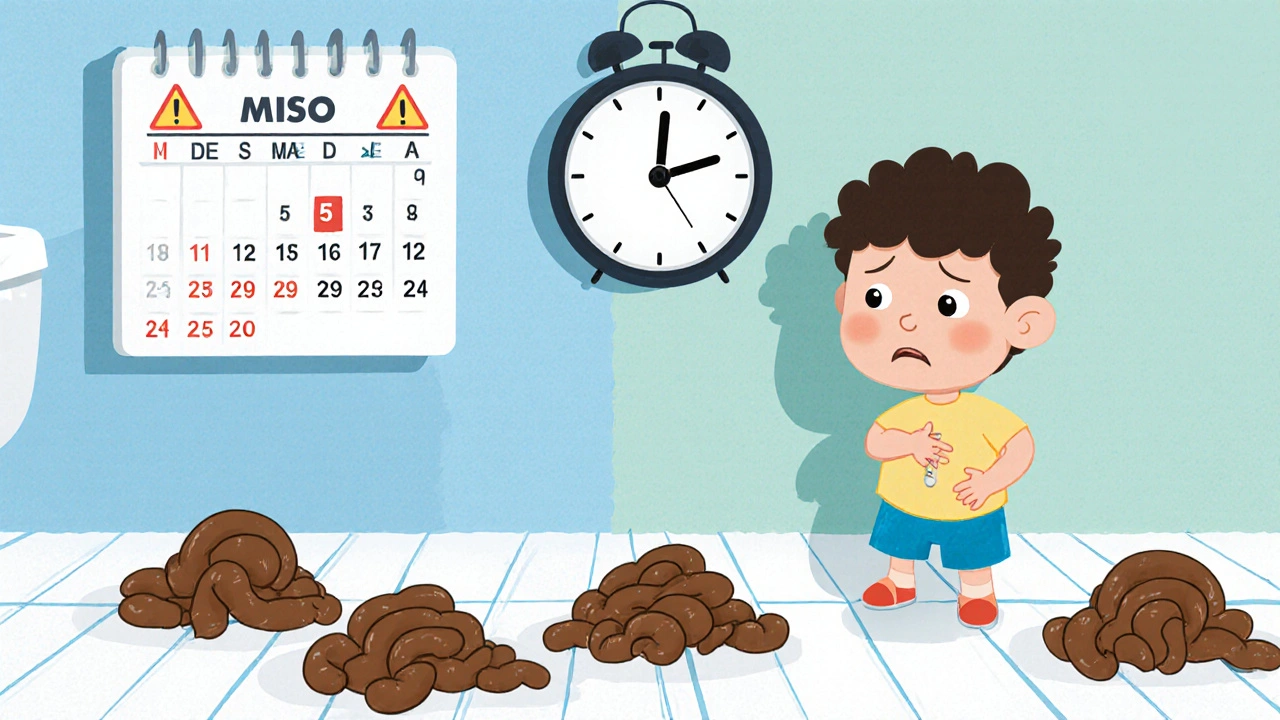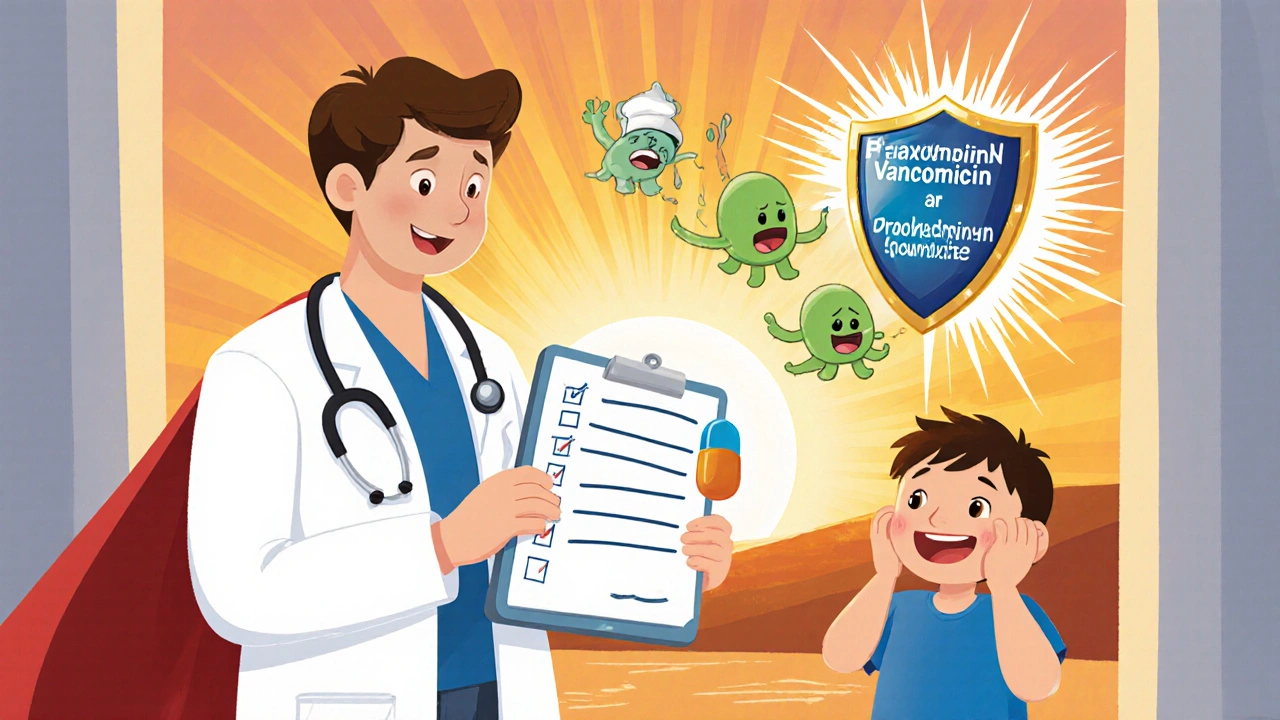CDI Symptom Checker: When to Call a Doctor After Clindamycin
This tool helps you assess your symptoms after taking clindamycin. Based on medical guidelines, it will tell you when to contact a healthcare provider or seek emergency care.
Your Symptoms
Your Risk Factors
Low Risk
No immediate action needed. Continue monitoring your symptoms. Contact your provider if symptoms worsen or persist beyond 48 hours.
Key Takeaways
- Clindamycin is one of the antibiotics with the highest risk of triggering Clindamycin CDI risk.
- Most cases appear within 5‑10 days of starting or finishing the drug, but risk can linger up to 12 weeks.
- Seek medical care if you have three or more loose stools in 24 hours plus abdominal pain, fever, or blood in stool.
- Older adults, immunocompromised patients, and anyone with a prior CDI episode should call a provider after just 24 hours of symptoms.
- Switching to a lower‑risk antibiotic, when appropriate, and early specialist consultation cut complications by more than half.
What is Clindamycin?
When taking Clindamycin a lincosamide antibiotic commonly used for skin, dental, and anaerobic infections, it attacks gram‑positive bacteria and some anaerobes. Its spectrum is narrow, but that narrowness is a double‑edged sword: while it hits the target bugs, it also wipes out many of the harmless microbes that keep Clostridioides difficile a spore‑forming bacterium that can cause severe colitis when the gut flora is disturbed in check.
Why Clindamycin Raises the C. difficile Alarm
Studies repeatedly show clindamycin tops the list for antibiotic‑associated C. difficile infection (CDI). A 2019 analysis of 150,000 patients reported the highest odds ratio for CDI among all drugs evaluated. The drug’s half‑life in the gut (3‑4 hours) means it lingers long enough to let C. difficile spores germinate and produce toxins.
Key numbers from the literature:
- Patients on any antibiotic are 7‑10 times more likely to get CDI; clindamycin pushes that risk even higher.
- Absolute risk remains low-about 1‑2 % of clindamycin courses-but that equals thousands of cases nationwide each year.
- Median onset after the first dose is 5‑10 days; 68 % of clindamycin‑related CDI appears within two weeks.
Who Is Most Vulnerable?
Not everyone who finishes a clindamycin prescription will develop CDI. Certain groups face a steeper climb:
- Age > 65 years - gut diversity naturally declines with age.
- Immunocompromised status - solid‑organ transplant, chemotherapy, HIV.
- Previous CDI episode - the spores can linger and reactivate.
- Renal impairment - slower drug clearance can amplify gut exposure.
If you fall into any of these categories, act faster: call your doctor after the first 24 hours of watery stools.
Symptoms That Signal a Problem
The classic CDI picture is “three or more loose stools in 24 hours plus abdominal cramping.” However, the guidelines sharpen the alarm for high‑risk patients:
- Fever > 101.3 °F (38.5 °C).
- Severe abdominal pain or distension.
- Blood, pus, or black tarry material in the stool.
- Signs of dehydration - low urine output, dizziness, dry mouth.
- Rapid heart rate or low blood pressure (possible fulminant CDI).
When any of these appear while you’re on clindamycin or within twelve weeks after stopping, seek care immediately.

When to Call Your Provider vs. Head to the ER
Not every bout of diarrhea needs an ER visit, but you shouldn’t wait for it to get out of hand.
- Office or urgent‑care visit: three unformed stools in 24 hours + mild fever or cramping, especially if you’re >65 or immunocompromised.
- Emergency department: any blood in stool, vomiting, severe abdominal pain, dizziness, or signs of shock.
- Call 911 if you notice rapid breathing, bluish lips, or sudden loss of consciousness.
Early evaluation (within 48 hours of symptom onset) cuts the risk of surgery-colectomy rates drop from 18 % to under 9 % in recent studies.
How Doctors Confirm CDI
Diagnosis combines clinical signs with a lab test. The most common approach is a stool PCR that looks for toxin genes. Some labs still use enzyme‑immunoassay (EIA) for toxins A and B, but PCR is more sensitive.
Key points for patients:
- Bring a fresh stool sample (no preservatives) to the clinic.
- If you’re on laxatives, hold them for 24 hours before collection.
- Don’t start over‑the‑counter anti‑diarrheals until a clinician advises-stopping toxin clearance can worsen disease.
Treatment Options and Why the Choice Matters
Once CDI is confirmed, the first‑line drugs are oral fidaxomicin a narrow‑spectrum macrocyclic antibiotic that targets C. difficile with minimal impact on normal flora and oral vancomycin a glycopeptide given as a swallow‑able capsule for CDI. Metronidazole is now second‑line because it carries a higher recurrence rate.
Why it matters:
- Fidaxomicin reduces recurrence to about 15 % vs. 25 % with vancomycin.
- Both drugs spare the microbiome far better than clindamycin, which is why avoiding clindamycin when alternatives exist is a core stewardship recommendation.
For fulminant cases (hypotension, ileus, megacolon), high‑dose IV metronidazole plus oral vancomycin is standard, and surgery may be required.
Preventing CDI After a Clindamycin Course
Even if you never develop symptoms, the gut remains vulnerable for weeks. Here are practical steps:
- Probiotic use: strains like Saccharomyces boulardii or Lactobacillus rhamnosus have modest data for reducing CDI risk, especially in older adults.
- Stay hydrated and keep a food diary to spot early changes in stool consistency.
- Avoid unnecessary antibiotics for viral illnesses; ask your provider about alternatives like trimethoprim‑sulfamethoxazole for certain skin infections.
- If you’ve had CDI before, discuss a follow‑up stool test 2‑4 weeks after treatment to ensure eradication.

Comparing Antibiotic Risks for CDI
| Antibiotic | Typical Indications | CDI Risk (Relative Scale) | Notes |
|---|---|---|---|
| Clindamycin | Skin, dental, anaerobic infections | Very High | Highest odds ratio in multiple studies |
| Fluoroquinolones (ciprofloxacin, levofloxacin) | UTIs, respiratory infections | High | Associated with ribotype 027 outbreaks |
| Third‑generation cephalosporins | Severe pneumonia, meningitis | High | Broad gram‑negative coverage knocks out competitors |
| Penicillins + β‑lactamase inhibitor | Sinusitis, skin infections | Moderate | Risk lower than clindamycin but still notable |
| Metronidazole | Anaerobic infections, protozoa | Low | Often used for mild CDI |
| Fidaxomicin | First‑line CDI | Very Low | Minimizes microbiome disruption |
Checklist: When to Call a Doctor After Clindamycin
- 🟢 Three or more watery stools in a 24‑hour period.
- 🟢 Abdominal cramping or pain.
- 🟢 Fever > 101.3 °F (38.5 °C).
- 🟢 Blood or pus in the stool.
- 🟢 Dehydration signs (dry mouth, dizziness, low urine output).
- ⚠️ If you’re >65, immunocompromised, or had CDI before, call after the first 24 hours of any of the above.
- ⚠️ If you notice swelling of the abdomen, severe pain, or rapid heart rate, go to the ER now.
Frequently Asked Questions
Can a single dose of clindamycin cause C. difficile?
Yes. Case reports show even one peri‑operative dose can trigger CDI in a susceptible gut, though the overall chance stays under 2 %.
How long does the risk last after I stop taking clindamycin?
Risk peaks during therapy and in the first week after stopping, but it can extend up to 12 weeks. Most cases (68 %) appear within two weeks.
Are probiotics effective at preventing CDI?
Evidence is mixed. Certain strains (S. boulardii, L. rhamnosus) have modest benefit, especially for older adults, but they are not a substitute for avoiding high‑risk antibiotics.
What should I tell my doctor if I suspect CDI?
Mention the exact antibiotic (dose, duration), describe stool frequency and consistency, note any fever or abdominal pain, and share any prior CDI history or immunosuppressive conditions. This helps the clinician decide on testing and treatment.
Is it ever safe to stay on clindamycin if I develop diarrhea?
Generally no. If diarrhea meets the three‑stool threshold, stop the drug and discuss alternatives. Continuing risks progression to fulminant CDI.
Bottom Line
If you’re prescribed clindamycin, stay alert for watery stools, fever, or abdominal pain for up to three months after you finish the prescription. Early contact with a healthcare professional can turn a potentially serious infection into a brief, treatable episode.

Clindamycin is a powerful drug that can save you from serious infections, but it also carries a hidden danger. The gut microbiome is a delicate ecosystem that keeps harmful bacteria like C. difficile in check. When clindamycin wipes out many of the friendly microbes, it creates a vacuum that the spores can exploit. Studies have shown that the risk of CDI rises sharply during the first two weeks of therapy. If you notice three or more loose stools in a day, that is a signal to pay attention. Add to that any abdominal cramping, fever, or blood in the stool and the situation becomes urgent. Older adults and people with weakened immune systems are especially vulnerable, so they should monitor symptoms closely. The good news is that early medical attention can dramatically reduce the chance of severe complications. A simple office visit can lead to stool testing and the right antibiotic, such as fidaxomicin or vancomycin. These treatments target C. difficile while sparing the rest of your gut flora. In many cases, patients recover quickly once the appropriate therapy is started. However, delaying care can lead to dehydration, toxic megacolon, or even the need for surgery. Staying hydrated and avoiding over‑the‑counter anti‑diarrheals until a doctor advises otherwise is wise. Probiotic supplements like Saccharomyces boulardii may offer some protective benefit, especially for older patients. If you have taken clindamycin in the past and had CDI before, alert your provider right after the first loose stool. Remember, the risk can linger for up to twelve weeks, so keep an eye on your symptoms well after the prescription ends.
Honestly, the article scares people unnecessarily; most folks take clindamycin without ever seeing a single C. difficile case. The stats are blown out of proportion to push a fear‑mongering agenda. If you’re not bleeding or in shock, a quick over‑the‑counter fix is fine.
Look, the data isn’t some vague suggestion – it’s a cold hard fact that clindamycin tops the CDI charts. You think you’re immune? Think again, because the spores are lying in wait, ready to pounce when you ruin your gut flora. Ignoring those warning signs costs you more than a few miserable bathroom trips; it can end in a life‑threatening situation. So stop playing it cool and call your doctor the moment you notice anything out of the ordinary.
Clindamycin does its job, but the gut balance is fragile. Keeping an eye on stool changes is a small effort for a big payoff. If you’re in a high‑risk group, don’t wait – reach out early.